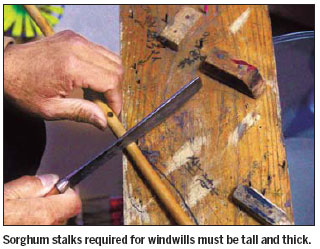Art
Dedicated craftsman makes toys of joy
Updated: 2011-04-27 08:02
By Wu Wencong (China Daily)
|
Wang Guohua never imagined he could earn a living making windmills until it was listed as a cultural heritage. Photos by Zou Hong / China Daily |
When talking to a Chinese about windmills, the first comment you will most likely hear will not be about the giant machines used to capture wind power. Instead, you will hear stories about a simple colorful toy and happy memories of the old times, when toys were a luxury.
When METRO visited the home studio of Wang Guohua, the inheritor of the tradition of the Beijing windmill, the 63-year-old was busy making wheels for the windmills.
"Sorry about the mess. It's either sticks or mud in our home," said Niu Junhua, Wang's wife and assistant.
 |
Windmills, which were first depicted in paintings during the Song Dynasty (960-1279), were originally used as part of the honor guard to welcome the God of Wealth on the second day of the Chinese new year.
"After that people would stick windmills near their doors and let them break into pieces to keep away the God of Poverty, who legend has it feared nothing but broken things," said Wang.
Made from sorghum stalks, gumming dirt, paper and prods, a good windmill should have a reasonable structure, a colorful look and a light silvery sound when standing against the wind, Wang said.
There are hundreds of detailed stages in the making of a windmill, but there are four main steps: cutting the stalks and connecting them with prods to form the structure; dyeing the paper and sticking it onto a loop to form the wheel; mixing mud with cotton to form the drum and covering it with stretched kraft paper, and finally connecting all the parts.
"Getting the raw materials is the biggest problem we are facing right now," said Wang.
He said the sorghum stalks should be tall and thick, but that type of sorghum produces a smaller crop and therefore few people grow it these days. The mud used has to have a high viscosity, which can only be found 5 to 10 meters below the ground. The dye must be extracted from plants and cannot be found in Beijing.
"My wife still keeps some land in her hometown in Hebei province to grow the sorghum we need," Wang said. "We collect the mud from construction sites when they are laying the foundations. Luckily we can still get the dye in Hebei province."
E-paper

War of the roses
European Chinese rose growers are beating their Chinese rivals at their own game
High-tech park gets big boost
At the source
Merchant of Venice
Specials

Sino-US Dialogue
China and the US hold the third round of the Strategic and Economic Dialogue on May 9-10 in Washington.

Drunk driving
Drunk drivers face a detention for one to six months and a revokation of their drivers' license.

V-Day parade
A military parade marking the 66th anniversary of the Soviet victory over Nazi.

